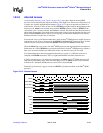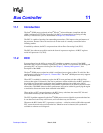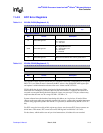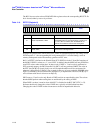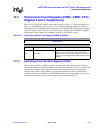
11-6 March, 2003 Developer’s Manual
Intel
®
80200 Processor based on Intel
®
XScale
™
Microarchitecture
Bus Controller
BCUCTL.TP allows software to determine if the BCU has any pending memory transactions. This
may be used to ensure that all memory operations have completed before attempting to modify
system state. For example, the code in Example 11-1 simply waits until the BCU is idle.
Of course, this sort of code should be in a cacheable region, or it may keep the BCU eternally busy
fetching the code!
If BCUCTL.EE is set, then the BCU performs ECC generation/checking as described in
Table 11-1. The other control bits (SC, SR) should only be modified while the EE bit is cleared.
To ensure correct operation, hardware waits until all pending operations are completed before
allowing the EE bit to take affect. Code similar to that shown in Example 11-2 is recommended for
enabling ECC.
3 Read / Write
EE - ECC Enable
0 = disable ECC generation and checking
1 = enable ECC
2 Read / Write
SC - Single bit Correct Enable
0 = disable single bit error correction
1 = enable single bit error correction
1 Read-unpredictable/ Write-as-1 Reserved.
0 Read / Write
SR - Single bit Error Reporting Enable
0 = disable single bit error reporting
1 = enable single bit error reporting
Table 11-2. BCUCTL (Register 0) (Sheet 2 of 2)
31 30 29 28 27 26 25 24 23 22 21 20 19 18 17 16 15 14 13 12 11 10 9 8 7 6 5 4 3 2 1 0
T
P
E
V
E
1
E
0
E
E
S
C
S
R
reset value: all implemented bits are 0
Bits Access Description
Example 11-1. Loop to Wait on BCU
; Wait for BCU to finish all outstanding operations
waitLoop:
MRC P13, 0, R15, C0, C1, 0 ; read BCUCTL, update condition code flags
BMI waitLoop ; try again if BCU is busy (bit 31 set)
;
; Get here when BCU is no longer busy
Example 11-2. Enabling ECC
MACRO FLUSHALL
MCR P15, 0, R0, C7, C10, 4 ; Drain buffers
ENDM
enableECC:
FLUSHALL ; Finish pending memory operations
MOV R0, #0xA ; Set bits 3 and 1
MCR P13, 0, R0, C0, C1, 0 ; Set BCUCTL -- enable ECC




